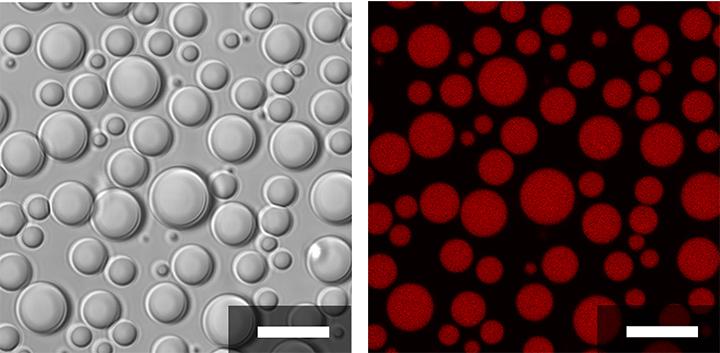Researchers make functional membraneless “protocells” out of short polymers

Credit: Fatma Pir Cakmak, Penn State
Protocell compartments used as models for an important step in the early evolution of life on Earth can be made from short polymers. The short polymers, which better approximate the likely size of molecules available on the early Earth, form the compartments through liquid-liquid phase separation in the same manner as longer polymers. Although they have no membrane separating them from their environment, the protocells can sequester RNA and maintain distinct internal microenvironments, in some ways even outperforming similar compartments made from longer polymers.
A paper describing the research, by Penn State scientists, appears November 23, 2020 in the journal Nature Communications.
“An important step for the early evolution of life on Earth is compartmentalization,” said Christine Keating, Distinguished Professor of Chemistry at Penn State and one of the leaders of the research team. “Living things need to be somehow separated from their environment. We wanted to know if we could make compartments that could function like protocells out of molecules that were more similar in size to the molecules that would have been available on Earth when life was beginning.”
The researchers create the compartments, called ‘complex coacervates,’ by combining two oppositely charged polymers in a solution. The polymers are attracted to each other and can form droplets through liquid-liquid phase separation, similar to oil droplets forming in a salad dressing as it separates. Depending on the conditions, the polymers can remain uniformly distributed in the solution, they can form the protocell-like coacervates, or they can clump together to form solid aggregates.
The researchers compared different lengths of polymers composed of charged units, from 1 to 100 units. The longer polymers have higher charges, are more strongly attracted to each other, and can form compartments more easily in a broader set of experimental conditions.
“We tested a large number of combinations of polymers types and lengths to try to establish the parameters for compartment formation,” Fatma Pir Cakmak, a graduate student at Penn State at the time of the research and first author of the paper. “We found that polymers as short as five units long could form stable compartments.”
The researchers then tested the ability of the compartments made from the short polymers to perform certain functions of a protocell. The compartments were stable in a variety of salt concentrations and, depending on the polymer combinations, were able to maintain an apparent pH inside that compartment that was different than the pH of the surrounding solution.
“We don’t know what the conditions were in which life formed,” said Saehyun Choi, a graduate student at Penn State and one of the authors of the paper. “It could have been in the ocean, in brackish water, or in freshwater. The compartments were stable in salt concentrations high enough to suggest that they are a relevant model for any of these situations.”
When single-stranded RNA molecules were added to the solution, compartments made from shorter polymers were better able to sequester the RNA than compartments made from longer polymers. RNA molecules inside the compartments were concentrated by as much as 500 times the surrounding solution. Double-stranded RNA molecules were also sequestered by the compartments and were more stable in the compartments made from shorter polymers.
The research team also tested the ability of RNA to maintain its folding and three-dimensional structure inside the compartments.
“Under the conditions that we tested, RNA formed much of its secondary structure but did not maintain its fully native folding inside the compartments,” said McCauley O. Meyer, a graduate student at Penn State and an author of the paper. “We saw basically no difference based on the size of the polymers forming the compartments, so it may just be that we didn’t have enough of a key component–something like magnesium, which is important for fully native RNA folding.”
The results show that even with simple small components, compartments that are capable of many of the hallmarks of protocells can be made.
“It’s a powerful finding to see that we can make these compartments out of such short polymers and in some ways, like accumulating RNAs, they function better than ones made from longer polymers,” said Keating. “Our findings suggest that even if only smaller molecules were available on the early Earth, functional compartments could form. Over time, larger molecules could have been incorporated as they became available.”
The researchers emphasize that the polymers they are using capture the essence of plausible early-Earth molecules but are likely not like the ones available on the early Earth, except in size. They stated that they are not attempting to recreate the conditions of early Earth that led to the evolution of life.
“What we’re after is not the precise transcript of what happened on Earth billions of years ago,” said Phil Bevilacqua, Distinguished Professor of Chemistry and of Biochemistry and Molecular Biology at Penn State and one of the leaders of the research team. “Instead, we want to know how feasible it is for life to start. We’re exploring boundary conditions, and you have to have short polymers before you get long polymers.”
###
The research was funded by the NASA Exobiology program.
Media Contact
Sam Sholtis
[email protected]
Related Journal Article
http://dx.




